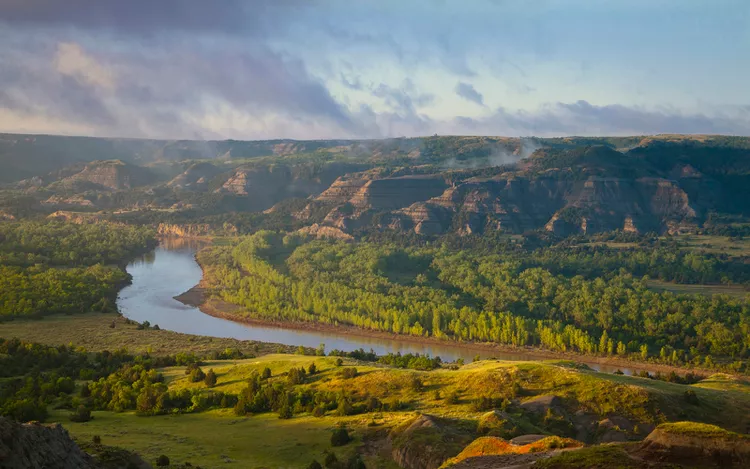Summary of Attractions in Theodore Roosevelt National Park
Discover an oasis in the North Dakota badlands.

Badlands are one of the trademarks of the west. You can find them in Montana and parts of Utah, as well as northern-central states like South Dakota, which famously has an entire National Park dedicated to them. Heavily eroded and mostly devoid of vegetation, these dry, pockmarked landscapes tend to be difficult to traverse, and certainly, don’t lend themselves to easy foraging. For hundreds of years, the Lakota people who lived in the area shrewdly kept their distance, referring to them as mako sika (literally ‘bad lands’).
However, Theodore Roosevelt National Park is a unique exception. Though technically classified as badlands, the 70,000-acre swath of prairie grasses, sagebrush, and vivid painted canyons is an exceptionally lush oasis amid the state’s typically brown and yellow plains. The park sits alongside the Little Missouri River, providing an essential water source to the surrounding wildlife.
Wondering what to do on your next visit to North Dakota? These are the six can’t-miss things to do in Theodore Roosevelt National Park.
Lock Eyes with a Bison
No matter where you drive, your chances of coming within spitting distance of the shaggy-haired giants are pretty good: bison, wild horses, bighorn sheep, and deer all use the river as their main water source, roaming freely throughout the park. If it’s wild horses you’re after, however, stick to the South Unit, where sightings are more frequent. You can also ride a horse (not one of the wild ones) through the hills and splash across the Little Missouri River.
Go Off-Road in the Canyons
One way to truly find solitude in this great wilderness is to explore the park’s less-frequented North Unit. Set back 50 miles from the Interstate, it’s certainly more remote but well worth the journey. Start with a 14-mile scenic drive to Oxbow Overlook before pulling over and following one of the many self-guided nature trails. Here, the maze-like network of paths will lead you past steep canyons and colorful coulees marked by vivid gray bentonite clay, baked red rock, and black coal veins.
Traipse Through the Woods
In the floodplains that hug the Little Missouri River, dense cottonwood forests have sprung up, home to a dazzling ecosystem of wildlife. From beavers and white-tailed deer to great-horned owls, it won’t be long before you’re channeling your inner Snow White, singing in call-and-response with all the woodland creatures.
Float Down the River
Once spring comes, one of the best ways to explore the park is on the water. Unpredictable rainfall can make the Little Missouri River’s levels fluctuate wildly, going from knee-deep pools one minute to raging torrents the next; therefore, prospective kayakers and canoers are encouraged to call ahead of their trip. Assuming conditions are right, floating down this 268-mile stretch of river (or a portion of it) is like riding a conveyor belt through paradise. Just sit back, stare up at the clouds, and feel yourself recharge.
Step Inside Teddy Roosevelt’s Cabin
When Theodore Roosevelt first visited this land to hunt buffalo in 1883, no one (least of all him) could have predicted that in a mere 18 years, he would become the 26th president of the nation. However, once he did, this beloved tract of ranch land took on greater significance. Learn about Roosevelt’s special connection to the badlands (and why they came to be named after him) by visiting his former dwelling, the Maltese Cross Cabin: a Ponderosa pine log cottage located behind the South Unit visitor center.
Pick Your Own Campsite
In this remote part of the country, the night sky is quite a wonder. For a real adventure, request a backcountry permit at the visitor center. From there, you’ll have free rein to set up your tent anywhere within the park, as long as it’s within a quarter mile of the road. Watching the dark outlines of the hills fade into the night sky, seeing the Milky Way appear in their place, and embracing the tranquility is utterly enchanting.





